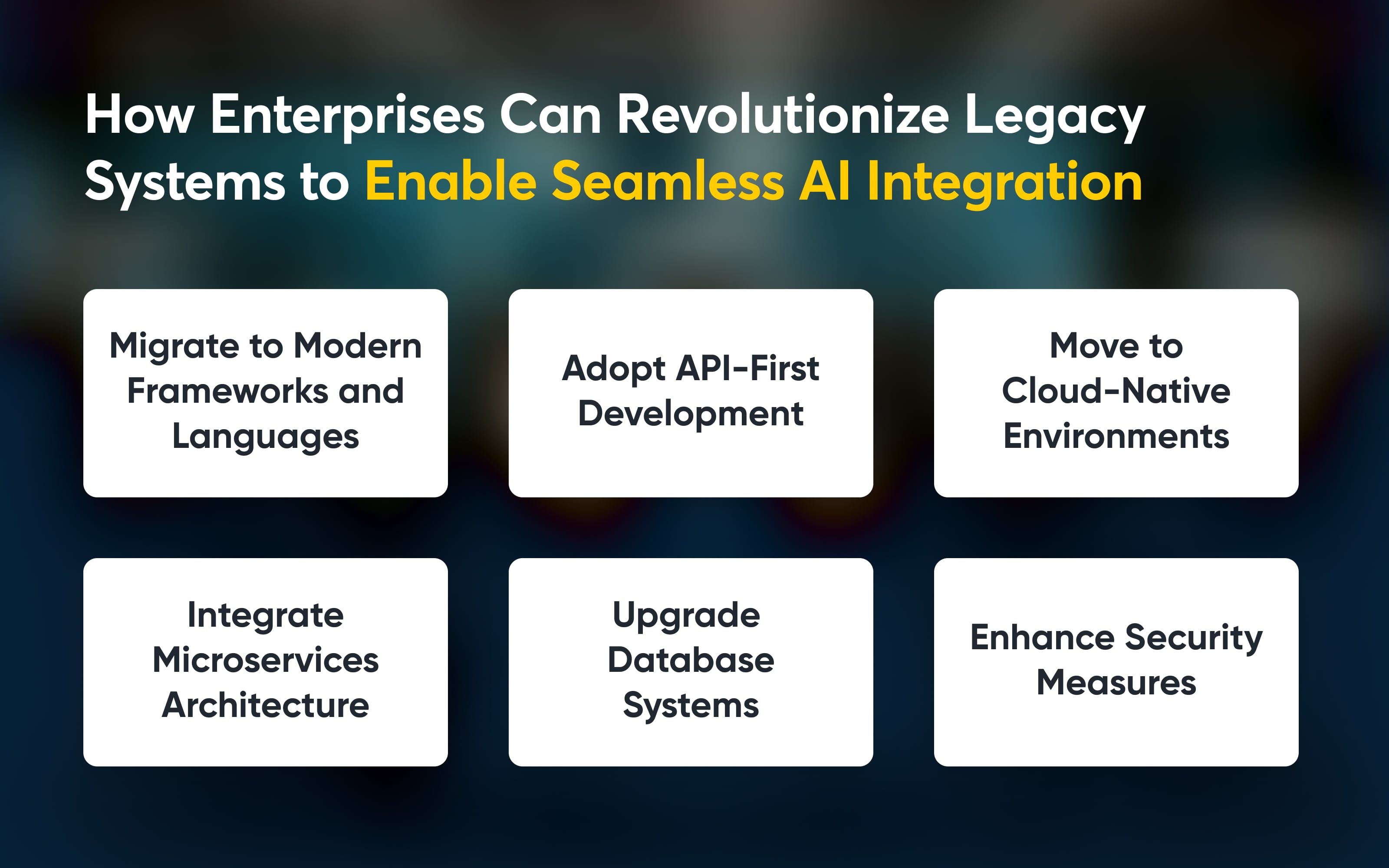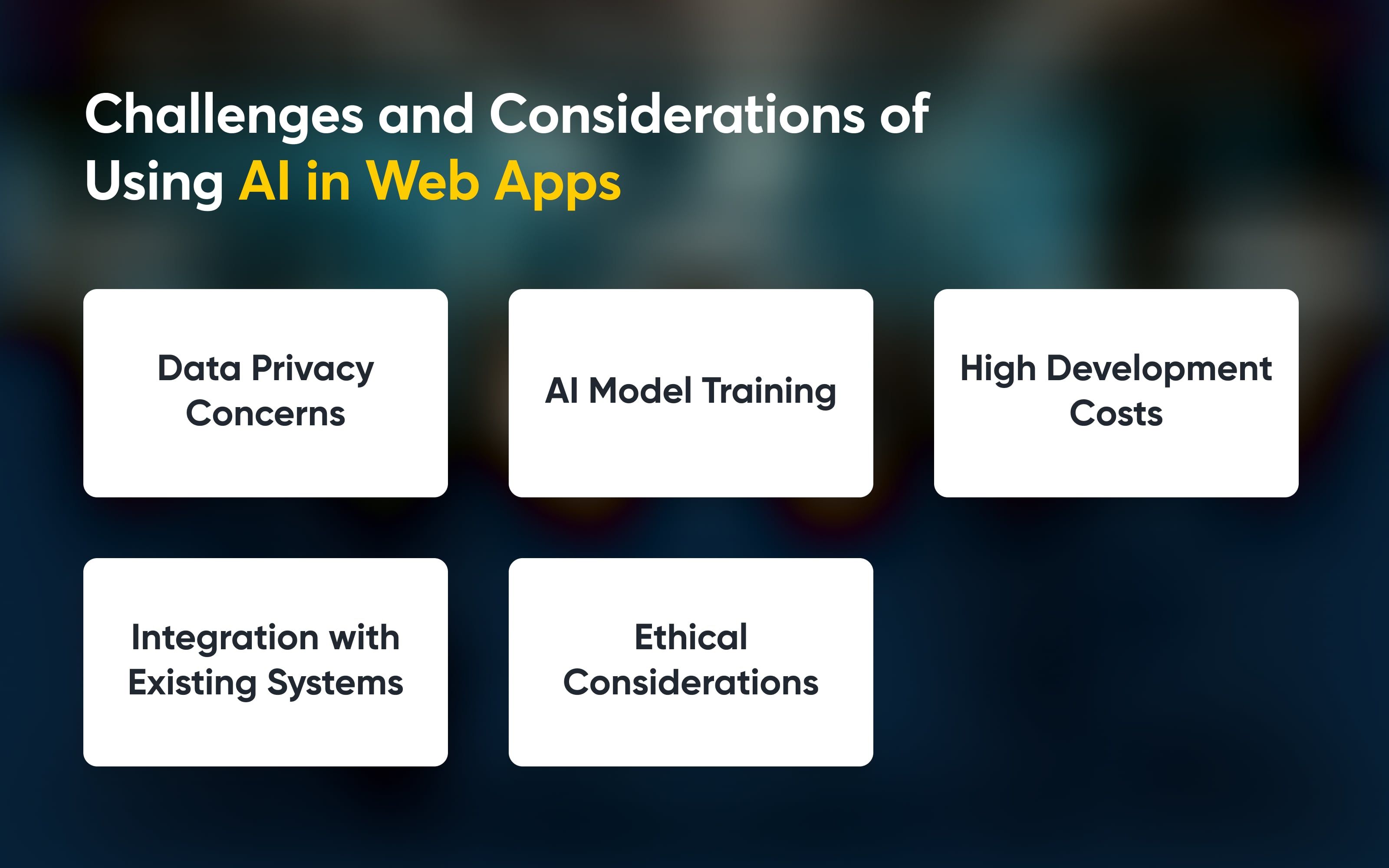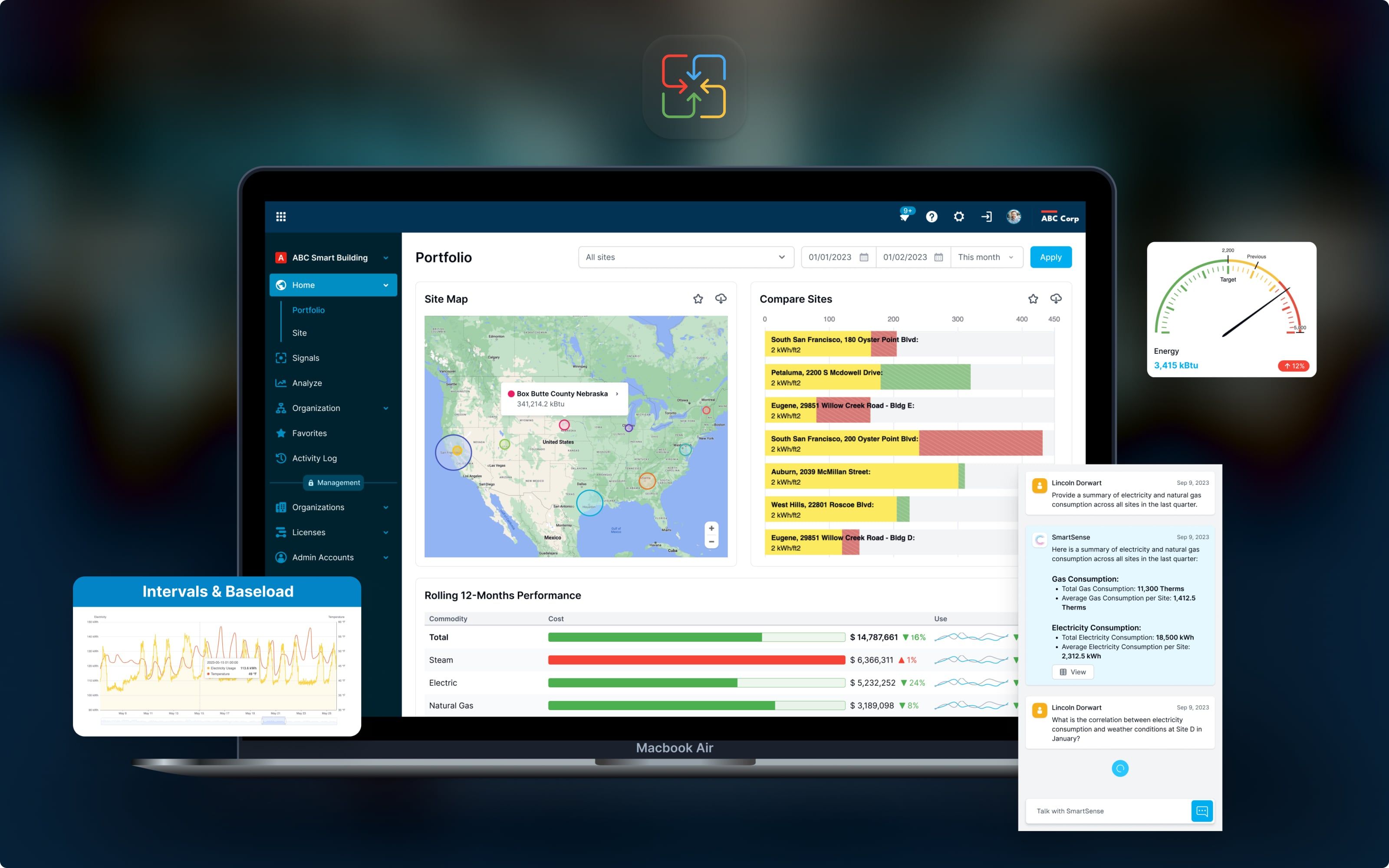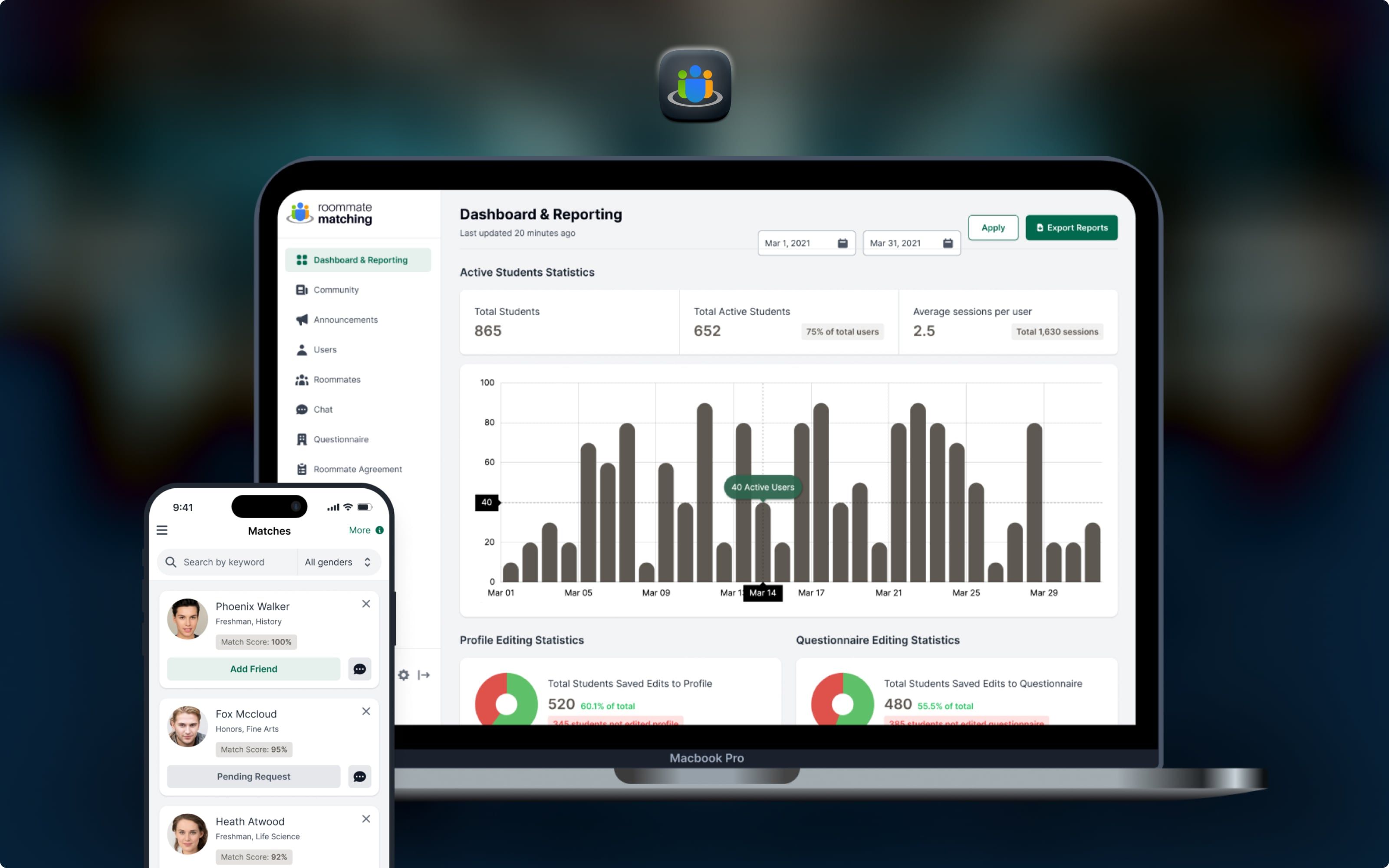Traditional web applications have long been integral to enterprises, supporting daily operations like workflow management, data processing, and customer engagement. While these tools help streamline processes, they often rely on static functionalities that lack adaptability to rapidly changing business needs.
However, AI in web development is set to transform this landscape by introducing intelligent, data-driven solutions that adapt, learn, and optimize over time. From enhancing personalization to automating complex tasks, AI-powered web applications enable businesses to operate more efficiently and make smarter decisions.
This blog post highlights how AI revolutionizes custom web apps, helping enterprises build responsive websites that automate workflows, drive higher user engagement, optimize web performance, and boost conversion rates. Additionally, you’ll discover the benefits and key impact of AI-driven web solutions for enterprises and the challenges of adopting AI in web apps. Furthermore, you’ll learn how enterprises can modernize their legacy systems that support the integration of AI and advanced technologies.
What are AI-Driven Web Applications
AI-driven web apps are web-based applications that leverage Artificial Intelligence to deliver intelligent, dynamic, and user-centric functionalities. These apps use machine learning, natural language processing, and data analytics to analyze user behavior, predict needs, and automate tasks. Unlike traditional web apps, AI-driven apps adapt and improve over time, offering personalized recommendations, real-time insights, and enhanced decision-making capabilities.
The power features like chatbots, predictive analytics, and automated workflows make them ideal for businesses looking to streamline operations and boost user engagement. By integrating AI, these apps transform static user interactions into responsive, data-driven experiences tailored to individual preferences and needs.
Also Learn: How to Build Visually Stunning Web Applications
Benefits of AI in Custom Web Development for Enterprises
AI revolutionizes web development by empowering enterprises with intelligent, adaptive applications that drive business growth. Here's how enterprises benefit from leveraging AI in web development to build scalable, efficient, and user-centric web applications.
- Automated Workflow: Enterprises can streamline repetitive tasks with AI workflow automation, saving time and allowing teams to focus on strategic priorities.
- Enhanced Efficiency: AI helps improve operational efficiency by optimizing processes and ensuring web apps run smoothly, even at scale.
- Reduced Operational Cost: By automating workflows and reducing resource inefficiencies, AI enables enterprises to lower development and maintenance costs effectively.
- Enhanced Decision-Making: AI provides actionable insights and predictive analytics, empowering enterprises to make smarter, data-driven decisions for better outcomes.
- Personalized User Experience: With AI, enterprises can deliver tailored experiences, offering relevant content and recommendations to enhance user satisfaction and loyalty.
- Optimized Web Performance: AI helps ensure websites are fast, responsive, and reliable, providing seamless experiences across different devices and platforms.
- Higher Engagement Rate: Enterprises can create more interactive and captivating user experiences, encouraging visitors to stay longer and explore more.
- Better Conversation Rates: AI enhances user journeys by offering personalized recommendations and streamlining the process, helping enterprises convert website visitors into loyal customers.
- Increased Web Security: Enterprises can overcome threats in real-time and safeguard sensitive data from potential cyberattacks and unauthorized access by using AI-powered web security solutions.
How Enterprises Can Revolutionize Legacy Systems to Enable Seamless AI Integration

Transforming legacy systems to integrate AI and advanced technologies begins with updating outdated architectures and frameworks. Traditional systems often rely on older languages like COBOL or C++ and rely on rigid, server-side rendering models that lack compatibility with modern technologies like AI and advanced machine learning.
These limitations hinder the ability to implement intelligent automation, predictive analytics, and real-time data processing—key components driving AI-powered custom web development.
To bridge this gap, enterprises need to modernize their legacy systems using modern programming languages and frameworks that fully support the integration of AI and cloud-based services and enable seamless scalability for evolving business requirements. For this purpose, they need to:
1. Migrate to Modern Frameworks and Languages
Refactor legacy codebases into cutting-edge web development frameworks like React, Angular, or Vue.js, combined with backend technologies like Node.js, Django, or Spring Boot. These frameworks provide the flexibility to build dynamic, real-time web applications while offering compatibility with AI-powered APIs, machine learning libraries, and cloud-based tools. Furthermore, migrating to modern technologies also improves scalability, enhances performance, and ensures long-term maintainability, enabling enterprises to adapt quickly to evolving user demands and integrate innovative features that drive better customer experiences.
2. Adopt API-First Development
Transitioning to an API-first architecture ensures that web applications can seamlessly communicate with AI, machine learning models, and cloud-based services. RESTful or GraphQL APIs promote modularity, allowing developers to connect new functionalities or external services without disrupting the entire system. Additionally, this approach fosters faster iteration, simplifies third-party integrations, and paves the way for AI-driven capabilities such as predictive analytics, intelligent automation, and personalized user experiences, giving enterprises a competitive edge in custom web development.
3. Move to Cloud-Native Environments
Migrating applications to cloud-native environments like AWS, Azure, or Google Cloud offers the scalability and computational power necessary for AI-driven web development. Cloud platforms enable hosting AI models, storing vast datasets, and implementing modern DevOps practices, such as continuous integration and continuous deployment (CI/CD). Moreover, enterprises can leverage cloud-based tools for advanced analytics, real-time processing, and flexible resource allocation, ensuring their applications remain agile, resilient, and capable of meeting the demands of rapidly changing business environments.
4. Integrate Microservices Architecture
Transforming monolithic web applications into a microservices architecture allows enterprises to create systems that are more agile, scalable, and resilient. Each microservice operates independently, managing specific tasks such as user authentication, AI-powered recommendations, or payment processing. This modular approach makes it easier to update or scale individual components without affecting the entire application. It enables seamless integration of advanced AI features while reducing downtime and enhancing the overall development workflow.
5. Upgrade Database Systems
Outdated databases often lack the speed and scalability needed for modern AI-powered applications. Transition to advanced databases like NoSQL solutions (e.g., MongoDB) or scalable SQL options (e.g., PostgreSQL) that can handle vast amounts of structured and unstructured data. Modern databases offer real-time processing capabilities, enabling applications to manage large-scale AI-driven operations such as dynamic user insights, predictive modeling, and intelligent data visualization, all critical for enhanced web development.
6. Enhance Security Measures
Legacy systems often fall short of meeting the security requirements of modern AI-powered web applications. Strengthen security by adopting advanced protocols such as HTTPS, OAuth, and multi-factor authentication to safeguard data during transmission. Incorporate AI-driven tools to detect and mitigate potential threats in real-time. With sensitive AI insights and user data at stake, enhanced security not only protects enterprise systems but also builds trust and confidence among users, a critical factor in the success of custom web applications.
As a result, modernizing legacy systems with these practices helps enterprises to create platforms ready to embed AI-driven features, such as recommendation engines, real-time analytics dashboards, and intelligent search. This modernization ensures greater compatibility, scalability, and security while driving innovation, enhancing user experiences, and meeting the challenges of a rapidly changing digital landscape.
The Role of AI-Driven Web Apps for Enterprises
AI-powered web apps are on the rise due to their ability to deliver smarter, more personalized, and efficient solutions. They adapt to user behavior, automate repetitive tasks, and provide real-time insights, offering a competitive edge to businesses. Below, we've outlined how enterprises can use AI in web development to streamline operations, personalize user interactions, and enhance overall efficiency.
1. Real-Time Insights for Data-Driven Decisions
AI enables enterprises to leverage real-time data to make informed decisions, driving agility and precision. AI-powered web apps analyze large datasets instantly, providing actionable insights on user behavior, market trends, and operational performance. These insights help businesses predict customer needs, optimize workflows, and identify potential risks. Along with these, other benefits include:
- Enhance Operational Efficiency: Real-time insights help enterprises optimize operations, address bottlenecks, and improve overall productivity.
- Boost Customer Engagement: With AI data analytics capabilities, enterprises can enhance their customer experiences by analyzing vast customer data in real-time.
- Proactive Problem Solving: Gathering real-time data helps in identifying potential challenges early, enabling enterprises to act quickly and minimize operational disruptions.
- Drive Business Growth: Analyzing trends in real-time to make informed strategic decisions that support innovation and competitive advantage.
2. Predictive Analytics to Forecast Demands
As the name suggests, AI predictive analytics can predict future outcomes by analyzing historical and real-time data patterns. When applied to custom web applications, businesses can make proactive decisions, identify patterns, optimize operations, and provide accurate predictions for future needs.
Let’s suppose an enterprise has built a web app for its eCommerce platform by integrating AI’s predictive analytics. Here’s what they can expect from this feature in their enterprise web solution:
- Enhanced Demand Forecasting: Enterprises can accurately predict customer demand to manage inventory effectively, reducing overstock or shortages.
- Optimized Pricing Strategies: Using predictive analytics, enterprises can analyzes market trends to set dynamic prices, ensuring competitiveness and profitability.
- Improved Marketing Campaigns: Predictive insights in web apps allow for targeted, personalized promotions, which maximizes ROI and drives better business outcomes.
- Supply Chain Efficiency: Using a web app with predictive analytics features, enterprises can anticipates supply needs and prevents bottlenecks, ensuring seamless operations and timely deliveries.
3. AI Chatbots for Effective Customer Support
One of the most widely adopted trends of AI in web development is AI-driven chatbots and virtual assistants. They leverage NLP, contextual understanding, and sentiment analysis to deliver personalized, human-like responses that enhance user experiences. Building a web app with an AI chatbot lets businesses streamline their customer support operations, resolve issues in real-time.
Some of the most common use cases of AI-driven chatbots in web app development include:
- Personalized Recommendations: AI chatbots analyze user data to suggest relevant products or services, enhancing the overall shopping experience.
- Feedback Collection: They gather customer feedback post-interaction, helping businesses improve products, services, and support processes.
- Payment Assistance: AI chatbots efficiently streamline payment processes, offering secure, intuitive, and hassle-free checkout experiences for users.
- Integration with CRMs: AI chatbots seamlessly integrate with CRMs, delivering instant customer insights to enhance team productivity and support.
4. AI-Driven User Behavior Analysis
Enterprises can analyze how users interact with their web app by understanding their user behavioral patterns. For this purpose, leveraging AI-driven user behavioral analysis comes in handy, which uses machine learning to track and interpret user interactions, such as clicks, navigation patterns, and session durations. Tools like heatmaps, session recordings, and predictive analytics help refine strategies for better user satisfaction and retention.
Furthermore, enterprises can use it for:
- Dynamic UI Adaptation: Real-time adjustments of interface elements to provide personalized, optimal experiences based on user behavior.
- Churn Prediction: Identifying disengaged users using AI to predict churn and implement retention strategies effectively.
- A/B Testing Automation: Leveraging AI to automate testing of variations and optimize designs or features for better performance.
- Customer Journey Mapping: Analyzing every step of user interactions to refine and enhance seamless, satisfying customer experiences.
- Behavior-Based Targeting: Using AI to tailor marketing and notifications based on user behaviors, enhancing personalization and engagement.
- Proactive Error Detection: Detecting potential usability issues before users report them, ensuring a smoother, uninterrupted user experience.
5. Personalized Content Recommendations and Discovery
AI-driven content discovery takes the user experience to the next level. It analyzes user behavior and preferences across different touchpoints to deliver tailored content. While navigating the website, users can discover relevant content. Enterprises can improve user retention rates, streamline navigation, and create a more intuitive, user-centric web experience using AI-driven content discovery.
Using AI in web development for content discovery, enterprises can:
- Segment Audience Effectively: Categorize users based on interests or demographics to deliver more relevant recommendations.
- Identify Upselling and Cross-Selling Opportunities: It leverages machine learning to detect patterns and associations, suggesting complementary or higher-value items.
- Provide Real-Time Suggestions: Offer dynamic recommendations during user sessions to increase engagement and satisfaction.
- Leverage Contextual Data: Utilize location, time, and device data to provide personalized content recommendations based on user context.
- Predict Future Interests: Analyze past user behavior and trends to anticipate future needs and recommend relevant content proactively.
Discover more: The Role of AI-Driven Apps in Content Discovery
6. Voice Search Optimization
With the rise in voice-based mobile and web apps, most customers now prefer hands-free interactions that offer convenience, speed, and accessibility. AI-powered voice search assistants use natural language processing (NLP) to interpret spoken queries, ensuring accurate and efficient results. This feature makes web applications more user-friendly, especially for individuals with disabilities or those on the go.
How does Voice Search Optimization benefit enterprises?
- Improve User Accessibility: Hands-free interactions empower users with disabilities and those multitasking, creating a more inclusive experience.
- Enhance Customer Experience: Fast, accurate results reduce friction and improve user satisfaction with a seamless, intuitive search process.
- Increase Engagement Rates: Encouraging repeat visits, this feature offers users an easy and efficient way to explore content.
- Tap into Emerging Trends: Meeting the growing demand for voice-activated searches enhances relevance and positions businesses as innovative leaders.
- Boost Conversion Rates: Simplifying the purchasing journey enables users to easily find products and complete transactions with ease.
7. Visual Search
AI enables users to search for products or information by uploading images, streamlining the search experience. This technology enhances convenience, eliminates language barriers, and delivers faster, more accurate results, improving overall user satisfaction and engagement across diverse industries.
Here’s how enterprises can integrate AI visual search into their web app development:
- Integrate Image Recognition Software: Use advanced AI algorithms to analyze and understand visual content uploaded by users for efficient search.
- Enable Real-Time Search Results: Provide instant, relevant visual search results by comparing uploaded images with a vast product database.
- Optimize Product Categorization: Automatically categorize and tag products based on visual attributes, ensuring accurate and efficient search results.
- Enhance User Experience with Suggestions: Offer related, personalized product suggestions based on the visual content of uploaded user images.
- Use Machine Learning for Accuracy: Continuously enhance the accuracy of visual search results by training AI models on real-time user data.
8. Sentiment Analysis
Web apps use AI sentiment analysis to gauge user emotions by analyzing comments, reviews, and social media posts. This helps businesses understand customer attitudes and uncover actionable insights. By identifying positive or negative trends, enterprises can enhance user experiences, address complaints, and build loyalty.
How Enterprises Can Use It:
- Analyze Social Media Sentiment: Monitor customer opinions and trending topics to understand brand sentiment and improve marketing strategies.
- Refine Customer Support: Enhance support quality by addressing customer emotions, improving resolutions, and boosting overall satisfaction levels.
- Enhance Online Reputation Management: Proactively protect brand image by addressing critical reviews and resolving customer concerns effectively.
- Tailor Website Content: Align website messaging and design with audience sentiment to enhance engagement and conversions.
- Boost Sales Strategies: Refine sales strategies with customer insights, improving product recommendations and personalized marketing efforts.
9. Fraud Detection
Web apps are increasingly targeted by cyber threats like account takeovers, fraudulent transactions, and data breaches. AI-powered fraud detection analyzes user behavior, transaction patterns, and anomalies in real-time to identify suspicious activities. Additionally, it also monitors patterns over time, adapting to emerging threats and continuously improving its detection capabilities.
Furthermore, enterprises can prevent unauthorized access, protect sensitive data, and mitigate financial losses by:
- Monitoring Login Activities: Detect unusual login patterns and promptly prevent unauthorized access to ensure the security of user accounts.
- Analyzing Transaction Patterns: Identify and block anomalies in payment activities to prevent fraudulent transactions and secure financial data.
- Securing User Data: Proactively detect potential breaches and prevent data leaks, ensuring the protection of sensitive user information.
- Combating Bot Attacks: Identify and mitigate automated attacks targeting web applications, ensuring safe and secure user interactions.
- Real-Time Risk Alerts: Instantly notify administrators of suspicious activities, enabling quick responses to minimize the impact of threats.
Challenges and Considerations of Using AI in Web Apps

While there are numerous benefits of integrating AI into web applications, there are also certain challenges, including data privacy concerns, implementation complexity, and the need for continuous optimization. Below are the most common challenges enterprises may face when integrating AI into the development of custom web apps.
Data Privacy Concerns
- Challenge: AI in web development requires vast amounts of user data to function effectively. This can raise privacy issues, particularly when dealing with sensitive or personal information. Without proper measures, it can lead to unauthorized access and data breaches.
- Solution: Implement strong encryption protocols and comply with data protection regulations like GDPR to ensure user privacy.
AI Model Training
- Challenge: Developing accurate AI models requires large, diverse data sets for training. Inaccurate or biased training data can result in poor AI performance, leading to incorrect predictions or decisions.
- Solution: Use diverse, high-quality data sets and fine-tune models regularly for accuracy and reliability.
High Development Costs
- Challenge: AI-powered web development often requires specialized tools, frameworks, and expertise, which can make the development process expensive and time-consuming.
- Solution: Leverage pre-built AI tools and frameworks to reduce development costs and time to market.
Integration with Existing Systems
- Challenge: Web applications with AI functionalities must be integrated seamlessly into existing IT systems, which may not be designed for AI tools. This can create compatibility issues and slow down the development process.
- Solution: Use API-driven integration and modular systems to ensure compatibility with existing enterprise infrastructure.
Ethical Considerations
- Challenge: The use of AI can raise ethical concerns, such as discrimination in algorithms or misuse of data. Ensuring AI is used responsibly is vital to maintaining user trust and meeting regulatory standards.
- Solution: Ensure AI is used responsibly by setting clear ethical guidelines and regularly auditing AI outputs
Successful Case Study of AI in Web Development
Discover how Cygnis has leveraged AI in web development to enhance user engagement and drive business growth for enterprises. Using advanced AI technologies and machine learning tools, we’ve helped enterprises by automating key processes, enhancing customer experiences, and improving decision-making. Let’s take a look at how we’ve implemented AI into building state-of-the-art web solutions:
AI-Powered Energy Monitoring System

Cygnis successfully developed a web-based AI-powered energy management system for commercial and industrial clients, addressing the complex challenges of optimizing energy consumption. The web solution transforms raw data from multiple sources into actionable insights by integrating advanced AI and machine learning models.
Real-time data integration, sophisticated algorithms, and easy-to-use dashboards make energy management efficient. The system is accessible via the web, ensuring clients can monitor and manage their energy consumption from anywhere, helping them reduce energy costs and achieve sustainability goals.
Features Include:
- Real-Time Data Integration: Seamlessly integrates data for continuous energy consumption monitoring and management.
- Advanced Data Mining: Identifies patterns in vast data sets to support informed decisions.
- AI-Driven Analytics: Transforms complex data into visual insights for improved energy management.
- Demand Forecasting Model: Predicts future energy consumption patterns for optimal usage and efficiency.
- AI Chatbot (Energy Agent): Provides instant, context-aware responses to enhance user engagement and support.
- IoT Sensor Integration: Collects real-time weather data, optimizing energy consumption through automated alerts.
Student Housing Platform

Another successful case study of an AI-driven web app is a student housing platform. Our team integrated AI technologies into building this platform to help our client streamline roommate matching, enhance social networking, and simplify housing administration. The platform uses AI-driven algorithms to assess student compatibility, providing personalized roommate suggestions.
The user-friendly design supports both students and staff, ensuring an optimal experience for everyone involved.
Features Include:
- Roommate Matching: AI-based compatibility assessment for personalized roommate suggestions.
- Social Networking: Tailored features for students to connect and build community.
- Customizable Forms: Flexible form creation tools for capturing student and institution-specific data.
- Term Management: AI-driven system for efficient academic term management and data rollover.
- Housing Applications: Automated housing applications for streamlined student registration.
- Analytics Dashboard: AI-powered insights for housing staff to manage processes effectively.
Conclusion
AI is significantly reshaping custom web development for enterprises by enhancing efficiency, personalization, and scalability. With the integration of machine learning algorithms, AI is streamlining complex processes such as user behavior analysis, content generation, and predictive analytics, making web applications smarter and more adaptive.
Enterprises are leveraging AI to create personalized user experiences, improve decision-making, and optimize resources in real-time. From automating repetitive tasks to enabling faster development cycles, AI is empowering businesses to stay competitive in an increasingly digital world. As AI continues to evolve, it holds the potential to further revolutionize how enterprises approach custom web development, driving innovation and growth.


